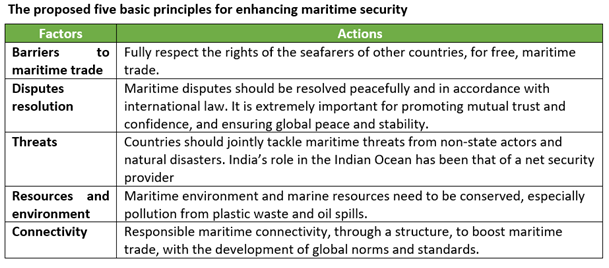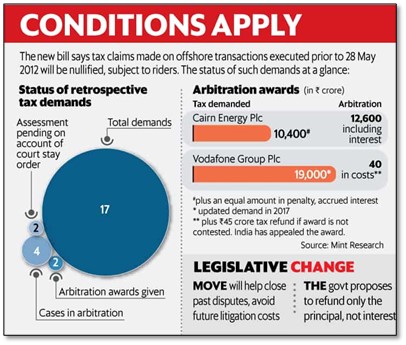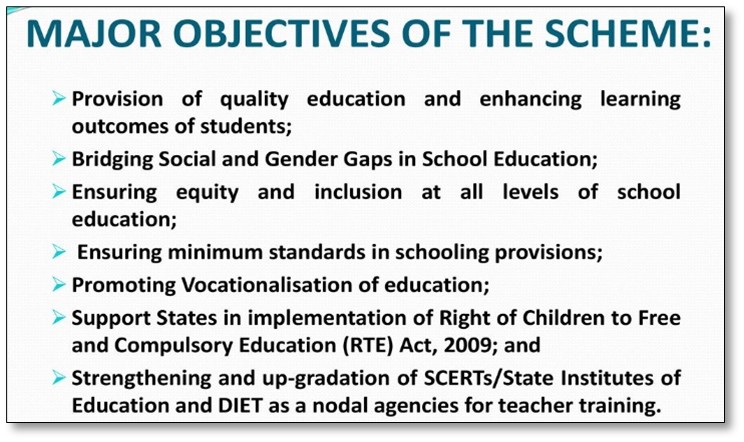Thursday, 8th July 2021
Covid-19 Pandemic and Violence Against Women
In News
The United Nations Economic and Social Commission for Asia and the Pacific (ESCAP) has presented a policy paper on the Covid-19 Pandemic and Violence Against Women in Asia and the Pacific.
Definition of violence against women (VAW)
- The United Nations’ Declaration on the Elimination of Violence Against Women defines VAW as “any act of gender-based violence that results in, or is likely to result in, physical, sexual or psychological harm or suffering to women, including threats of such acts, coercion or arbitrary deprivation of liberty, whether occurring in public or in private life.”
- With the evolving world of technology and expanding access to the internet, recent definitions of VAW have been revised to include digital violence. The United Nations General Assembly recognized digital VAW to include: Harassment, stalking, bullying, threats of sexual and gender-based violence, etc.
COVID-19 and VAW
- The true extent of VAW amidst Covid-19 is deemed the “shadow pandemic” by the United Nations. There are several factors that contribute to the increase in violence women experience during public health crises.
- There are three avenues contributing to more violence and less support during the Covid-19 pandemic: (1) increased exposure to perpetrators due to lockdown orders, child marriages and care responsibilities, (2) triggering stressful environments for perpetrators and (3) reduced support services like emergency health, security, and legal services.
- The Covid-19 pandemic is most likely to exacerbate two varieties of VAW: Intimate Partner Violence and Digital violence.
- Intimate partner violence (IPV) is an especially prevalent form of VAW. Worldwide, an estimated 30% of women who have been in a relationship have experienced IPV in their lifetime. This form of interpersonal violence is especially relevant during a lockdown when families are required to stay within the confines of their home.
- The pandemic is also likely to increase digital violence as the world turns to remote work and higher Internet usage for virtual socialization. Globally, Internet use during the pandemic has increased between 50 and 70 per cent. This facilitates exposure to incidents of sexual harassment, stalking, threats, and sex trolling.
Challenges of Measuring VAW
The nature of violence against women, a result of power imbalances and often occurring within the home, makes it difficult to measure. Incidents go unreported due to cultural norms that relegate IPV to the private domain, fear of backlash from the perpetrator, stigma associated with having experienced violence, and the belief that no help will come even if the violence is reported. According to the United Nations, fewer than 40% of women who experience violence seek help from authorities or shelters.
Policy recommendations
- Designate VAW support and women’s health services as “essential”
- Expand awareness within and access to law enforcement and the justice system
- Eliminate stigma and other barriers and develop innovative methods for reporting violence
- Increase ICT skills training for women
- Support violence prevention methods
- Encourage partnerships between governments, CSOs and international organizations
https://reliefweb.int/sites/reliefweb.int/files/resources/SDD_Policy_Paper_Covid-19-VAW.pdf
Fly Ash - Edukemy Current Affairs
In News: NTPC Ltd, in its endeavour towards 100% utilization of fly ash has invited Expression of Interest (EOI) for sale of fly ash from the designated ports of the Middle East and other regions.
What is Fly Ash?
- Fly ash is the finely divided residue that results from the combustion of pulverized coal in thermal power plants.
- It is transported from the combustion chamber by exhaust gases and is removed by particulate emission control devices, such as electrostatic precipitators or filter fabric baghouses.
- It consists of oxides of silicon, aluminum, iron and calcium. Magnesium, potassium, sodium, titanium, and sulphur are also present to a small extent.
Environmental Benefits vs Harmful Impacts
- Fly ash utilization, especially in concrete, has significant environmental benefits.
- Increasing the life of concrete roads and structures by improving concrete durability.
- Net reduction in energy use and greenhouse gas and other adverse air emissions when fly ash is used in place of manufactured cement.
- Reduction in amount of coal combustion products that must be disposed in landfills.
- Conservation of other natural resources and materials.
- However, on the other hand, fly ash particles in air can become lodged in the lungs, where they trigger asthma, inflammation, and immunological reactions.
- These particulates in one’s system could led to heart disease, cancer, respiratory diseases, stroke, etc.
Fly Ash Utilization
- NTPC hascollaborated with cement manufacturers and road construction institutions around the country to supply fly ash.
- To promote the use of fly ash in bricks in building construction, NTPC has set upfly ash brick manufacturing plants at its coal based thermal power plants.
- As per the MoEF&CC directives, NTPC stations must keep at least 20% of total fly ash producedin reserve for the issue to fly ash brick/blocks/tiles manufacturers and issuing fly ash free of cost to them.
- Over the last five years, fly ash utilization has grown by 80% in the country.
Other Government initiatives
- GST rates on fly ash and its products have been reduced to 5%.
- Aweb portal for monitoring of fly ash supply chain and a mobile based app ASHTRACK has been launched by the Government.
- Pradhan Mantri Awas Yojana (Urban) has focused on new construction technologies such as using fly ash bricksthat are innovative, and environmentally friendly.
- The government intends to utilize the fly ash produced in a radius of 300kms from its generating point after a nudge from NGT.
- Maharashtra was the first state to have come out with fly ash utilization policies.
Primary source: https://www.fhwa.dot.gov/pavement/recycling/fach01.cfm
https://pib.gov.in/PressReleasePage.aspx?PRID=1524384
https://pib.gov.in/PressReleasePage.aspx?PRID=1732626
Online Mobile App for Fish Farmers
In News: Union Minister for Fisheries, Animal Husbandry and Dairying has launched the Online Course Mobile App “Matsya Setu”.
About Matsya Setu
- The online course app has been developed to disseminate the latest freshwater aquaculture technologies to the aqua farmers of the country. It contains species-wise/subject-wise self-learning online course modules with basic concepts and practical demonstrations on breeding, seed production and grow-out culture of commercially important fishes like carp, catfish, scampi, murrel, ornamental fish, pearl farming, etc.
- Integrated practices like maintaining the soil & water quality, feeding and health management in aquaculture operations are also provided.
- Upon successful completion of each course module, an e-Certificate can be auto-generated.
- The app was developed by the ICAR-Central Institute of Freshwater Aquaculture (ICAR-CIFA), Bhubaneswar, with the funding support of the National Fisheries Development Board (NFDB), Hyderabad.
Need for such an App
- Learning the advanced technologies will certainly influence the adoption of scientific methods in fish farming; hence the productivity will be enhanced, and the income will be improved.
- With stagnation in marine fish production, aquaculture needs a renewed boost to invigorate the production.
- This app can also be an important tool to disseminate the latest information on different schemes among the stakeholders.
Primary source: https://pib.gov.in/PressReleasePage.aspx?PRID=1733198
https://pib.gov.in/PressReleasePage.aspx?PRID=1583635
Restoring Statehood to Jammu & Kashmir (J&K)
In News
The Prime Minister held an all-party meeting involving leaders of mainstream political parties from Jammu and Kashmir (J&K) to discuss the prevailing situation and the future course of action in the region.
Agenda of the All-Party Meeting
- This is the first outreach initiative from the Centre since the abrogation of Article 370 and 35A - that bestowed special status to J&K and privileges to its residents - and split the state into two union territories: J&K and Ladakh.
- The meeting focussed on five broad themes. These were Restoration of statehood; Greater clarity on Domicile laws and reserving government employment opportunities for people of the Union Territory; Restoring an elected dispensation; Ensuring the return of the displaced Kashmiri Pandits; and release of all political prisoners detained after August 5, 2019, when J&K was deprived of its statehood and special status.

Outcome of the meeting
- The Centre informed the J&K leaders of the steps that had been taken since the constitutional restructuring in the erstwhile state.
- Prime Minister reaffirmed Centre’s commitment to grant statehood to J&K. However, statehood will be considered only after delimitation of constituencies and assembly elections are held in the Union territory of J&K.
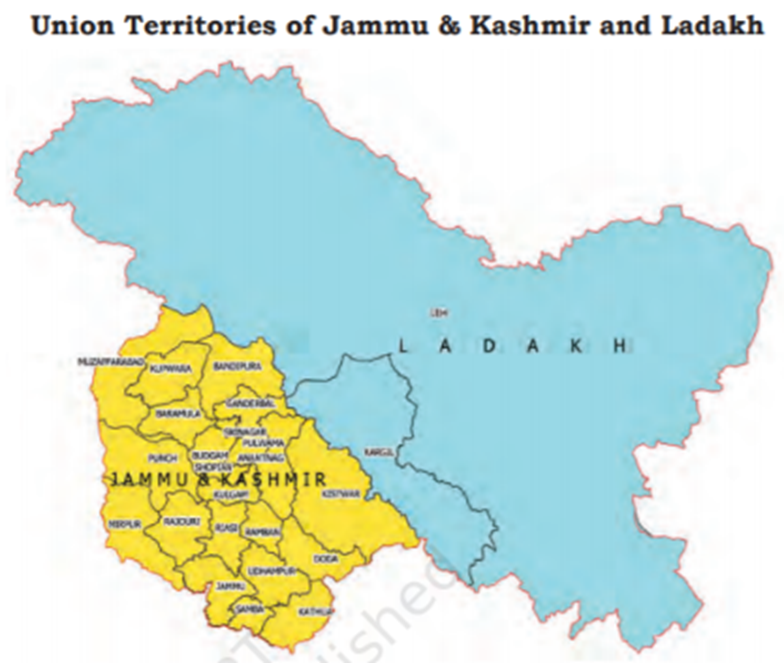
Situation in J&K since 2019: Time to review the policy approach towards J&K
- The two key objectives of the decisions of 2019 were ushering in a new era of development and prosperity in J&K and rooting out terrorism from Kashmir.
- However, there has been little development in J&K since 2019. For instance, the security lockdown post-2019 and the subsequent COVID-19 lockdown have only worsened the economic conditions.
- On terrorism and extremism, until the India-Pakistan ceasefire of February 2021, the security situation in the Kashmir Valley saw no significant improvement nor was there a major let-up in infiltration from across the Line of Control (LoC).
Before making any assessment of the underlying reasons for current discussions of possibility of statehood to J&K, it is important to, first, recognise a paradox of the Kashmir policy.
- Over the period, despite the usual political ups and downs, J&K state accepted and assimilated the Indian Constitution and its democratic institutions. Article 370 — focusing on exclusivity in certain spheres — played the role of satisfying the emotions of the state’s leaders and its people. Its nullification undermined the emotional connect. However, it is the loss of statehood that was considered unacceptable by most of J&K’s polity.
- Moreover, the democratic functioning at grassroot has been taking shape since 2019 decision. The mainstream parties in J&K have contested the District Development Council elections and performed creditably across all regions. This recognises the importance and popularity of local leaders among the masses. They have everything to gain by getting J&K’s Statehood back.
- Geopolitical Element: Centre’s effort comes not from domestic considerations alone.
- In the past few months, it has been made clear that a backchannel dialogue between India and Pakistan mediated by Gulf nations - Saudi Arabia, Qatar, and the UAE - is discussing assurances on J&K that would enable a broader bilateral dialogue.
- The potential for instability in South Asia following the US withdrawal from Afghanistan – where a Taliban takeover is highly probable – even as India’s border crisis with China in Ladakh remains unresolved, is likely to have also played a role in current policy reproachment of Central Government towards J&K.
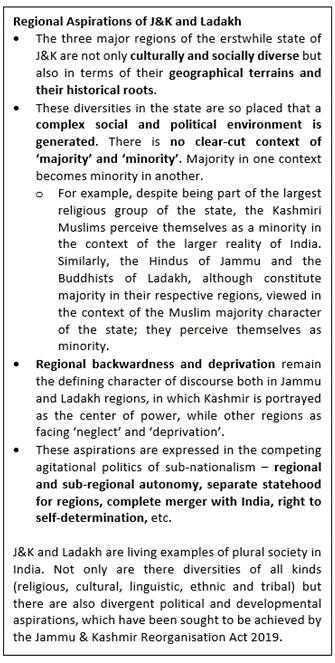
What Happens Next- Challenges and Way Forward
- Delimitation: Central Government wants delimitation – the redrawing of political boundaries – to take place first. And only after that is it promising a restoration of statehood. The delimitation question is complex.
- The sequencing is important. Kashmiri leaders are apprehensive of getting a Delhi like statehood (meaning one in which a central government-appointed Lieutenant Governor (LG) has more power than elected officials) if the elections result does not favour the ruling party in Centre.
- Therefore, the sequence is crucial, and why Kashmiri leaders are asking for statehood before delimitation and elections.
- Statehood with or without Special Status (Article 370): Restoring Article 370 in its pre-August 5, 2019, state did not really figure in the All-Party meeting. There is a consensus that this matter is before the Supreme Court and would wait for the judicial verdict. Whether Central government manages to get the mainstream political parties in J&K to accept the offer of Statehood without the return of special status remains to be seen.
- Implications beyond Borders: Restoration of statehood for J&K also has implications beyond the borders.
- India has endured regular international criticism over its handling of the Kashmir issue after the August 2019 decision. Normalization of the political process in J&K will serve to strengthen India’s democratic credentials and counter some of the anti-India narratives.
- There is an emergent and strong opinion within Pakistan that if India were to restore Statehood in J&K, it might open doors for a dialogue process. With this reality, both countries could move forward to revive some of the confidence-building measures like the cross-LoC bus service and trade, which had been stopped.
Way Forward
The government’s core objective now in J&K must be to restore democracy and hold elections. This, in turn, will require a three-step approach.
- convincing mainstream political leaders in J&K to participate in elections: Credible interlocutors from the Centre will be needed for each party to persuade them to join the electoral process. Only this will make it legitimate and representative.
- Releasing mainstream political leaders from custody: The government may also want to consider releasing leaders of moderate secessionist parties who have earlier shown some inclination to participate in elections.
- Security planning: The new security matrix — where Pakistan will seek to synchronise its offensive along with China — will also have to be taken into consideration. With the China-Pakistan Economic Corridor turning into a subcontinental military arc, India needs effective governance in J&K, not a garrison state. Democracy in J&K under the Indian Constitution is the best antithesis to Chinese concentration camps in Xinjiang and the Sino-Pak military authoritarianism.
Question: What are the regional aspirations of the people of J&K ? Analyse the impediments and opportunities in the current scenario.
Sources:
https://www.orfonline.org/research/rebooting-jammu-and-kashmir/
https://www.thehindu.com/opinion/lead/prepare-the-ground-for-a-naya-jk/article34980756.ece
https://www.orfonline.org/expert-speak/jammu-and-kashmir-all-party-meeting-of-compromises/
This Day in History -Vasco Da Gama
On July 8, 1497, Vasco Da Gama sailed from Lisbon with a crew of 170 men. He arrived at Calicut (now Kozhikode) on May 20, 1498. The four ships sailed more than 10,000 kilometres for over three months. He ultimately opened a sea route from Western Europe to Asia by way of the Cape of Good Hope, ushering in a new era in world history.

Source: https://www.britannica.com/biography/Vasco-da-Gama/The-second-voyage
https://www.indiatoday.in/education-today/gk-current-affairs/story/vasco-da-gama-326603-2016-07-08
Image of the Day- Live Animal Transport
This is the image of cattle stuck in transit, due to ships being withheld at ports due to the pandemic lockdowns. Ship transports completely fall outside of any regulations or animal-welfare standards. During the pandemic, maritime inspections of livestock carriers have fallen more than 30%, according to a Bloomberg analysis of publicly available data. The U.N. Food and Agriculture Organization has said live animal transport is “ideally suited for spreading disease.”
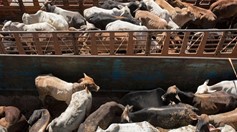
Sources: https://indianexpress.com/article/world/shipping-chaos-kills-1800-cows-animal-ban-7394595/
Maitree Power Project
- Context: The first unit of the Maitree power project at Rampal in Bangladesh will be commissioned in December 2021.
- It is a 2x660 MW coal-fired power station project being developed by the Bangladesh-India Friendship Power Company (BIFPCL), a 50-50 joint project of the governments of NTPC and Power Development Board, Bangladesh.
- The project is based on environment-friendly supercritical technology.
https://pib.gov.in/PressReleasePage.aspx?PRID=1733185
Grand Ethiopian Renaissance Dam
- Context: Ethiopia has started the second phase of filling the reservoir of Grand Ethiopian Renaissance Dam (GERD) on the upper Blue Nile.
- The GERD, formerly known as the Millennium Dam, is located on the Blue Nile River, about 40km east of Sudan.
- Ethiopia began the construction of the GERD in 2011.
- The 145-meter-tall and 1,780m long dam is Africa's largest hydroelectric project.
- This dam will generate approximately 6,000 megawatts of electricity which will support industrial growth in Ethiopia. It will also facilitate irrigation and reduce alluvium downstream.
Primary source: https://www.water-technology.net/projects/grand-ethiopian-renaissance-dam-africa/
Tele-Law Program
- Context: Justice Department has commemorated the milestone of crossing 9 lakh beneficiaries under its Tele-Law program.
- Tele-Law program was launched in 2017 to address cases at pre-litigation stage by the Ministry of Law and Justice in collaboration with the Ministry of Electronics and Information Technology (MeitY).
- Under this program, smart technology of video conferencing, telephone/instant calling facilities available at the vast network of Common Service Centre at the Panchayat level are used to connect the down-trodden, vulnerable and unreached groups with the panel lawyers for seeking timely and valuable legal advice.
Primary source: https://pib.gov.in/PressReleasePage.aspx?PRID=1733120
Non-Fungible Tokens
- Context: Market for Non-Fungible Tokens (NFT) surged to new highs with $ 2.5 bn in sales so far this year up from just $ 13.7 mn in the first half of 2020.
- Fungibility refers to an asset's ability to be exchanged with a similar asset without sacrificing its value.
- An NFT is a digital object such as a drawing, animation, piece of music, photo, or video with a certificate of authenticity created by blockchain technology which cannot be forged or otherwise manipulated.
- The virtual object, which is a computer file, can be exchanged or sold with its certificate.
- An NFT is a special cryptographically generated token that uses blockchain technology to link with a unique digital asset that cannot be replicated. Hence, all NFTs have a unique quality and a distinct value from any other similar token.
- They are bought and sold online, frequently with cryptocurrency, and they are generally encoded with the same underlying software as cryptos.
Primary source: https://www.deccanherald.com/business/technology/explained-what-are-non-fungible-tokens-and-how-is-it-different-from-bitcoin-961505.html
Ensuring water for the marginalized
Essence: The article is written in the backdrop of issues arising out of inefficient distribution and management of water resources in India. Though government aims to strike a balance between the right to water for all and its pricing and preventing overuse through various programs, but several surveys showed that disparity in water availability and use is increasing between economically lower and upper strata of the society. At policy level, there are diverse views relating to the impact of pricing of water on consumption behavior (inelastic). And the best way to reduce household water wastage would be to spread awareness. Presently, right to Water (recognized by international institutions too) is a derived right through the various judgements of the court under Article 21 of the Constitution. But there are several challenges associated due to rapid urbanization and depleting quality of water. A legislation clearly framing the rights and duties of various government and institutions for provisioning of water is the need of the hour.
Why should you read this article?
- To get an overview of issues related to water in India.
- To understand why pricing mechanism are not effective to control water consumption.
- To know what the provisions and programs are related to water management in India and what possible steps government and people should take for further rectification of the issue.
Article Link: https://www.thehindubusinessline.com/opinion/ensuring-water-for-the-marginalised-ii/article35198452.ece
A long road for migrant workers
Essence: The Supreme Court on June 29 pronounced its judgment in the migrant labour case. This article enlists the numerous guidelines as declared by the court to provide relief to workers. It also highlights the issues in implementing these measures.
Why you should read this article?
- Know about the important directives as laid down transportation for workers, implement ‘One nation One Ration Card’ scheme, etc.
- Understand various administrative problems and related challenges in implementing these measures.
Article Link: https://www.thehindu.com/opinion/op-ed/a-long-road-for-migrant-workers/article35203372.ece
India’s leadership in the fight against Japanese encephalitis
Background:
- In 2005, a massive outbreak of Japanese encephalitis occurred in the Indian states of Uttar Pradesh and Bihar. Thousands of people fell ill, and more than 1,500 died.
- When the outbreak hit, it was realized that that ongoing mosquito control measures, such as spraying insecticides were not stopping the virus.
- What was needed was an affordable, safe, effective, and long-term solution in form of Strategy for Japanese encephalitis which focusses on immunization.
Components of strategy for Japanese encephalitis:
- Vaccination of children which are at highest risk
- Expanding routine vaccination in endemic districts across the country.
How India fought back and paved the way for other countries to tackle JE
- It strengthened the routine immunization services due to which cases were reduced by 90 percent.
- It improved disease surveillance which helped in identification of areas which has unrecognized high incidence of the disease.
- National awareness-raising advocacy campaigns also helped in controlling the disease.
Outcome:
- India now plays the role of a role model for other countries to control the disease.
- WHO recommends the strategy that India employed which focusses on first conducting catch-up campaigns in high-burden districts before transitioning to routine immunization.
Share the article
Get Latest Updates on Offers, Event dates, and free Mentorship sessions.

Get in touch with our Expert Academic Counsellors 👋
FAQs
UPSC Daily Current Affairs focuses on learning current events on a daily basis. An aspirant needs to study regular and updated information about current events, news, and relevant topics that are important for UPSC aspirants. It covers national and international affairs, government policies, socio-economic issues, science and technology advancements, and more.
UPSC Daily Current Affairs provides aspirants with a concise and comprehensive overview of the latest happenings and developments across various fields. It helps aspirants stay updated with current affairs and provides them with valuable insights and analysis, which are essential for answering questions in the UPSC examinations. It enhances their knowledge, analytical skills, and ability to connect current affairs with the UPSC syllabus.
UPSC Daily Current Affairs covers a wide range of topics, including politics, economics, science and technology, environment, social issues, governance, international relations, and more. It offers news summaries, in-depth analyses, editorials, opinion pieces, and relevant study materials. It also provides practice questions and quizzes to help aspirants test their understanding of current affairs.
Edukemy's UPSC Daily Current Affairs can be accessed through:
- UPSC Daily Current Affairs can be accessed through Current Affairs tab at the top of the Main Page of Edukemy.
- Edukemy Mobile app: The Daily Current Affairs can also be access through Edukemy Mobile App.
- Social media: Follow Edukemy’s official social media accounts or pages that provide UPSC Daily Current Affairs updates, including Facebook, Twitter, or Telegram channels.

